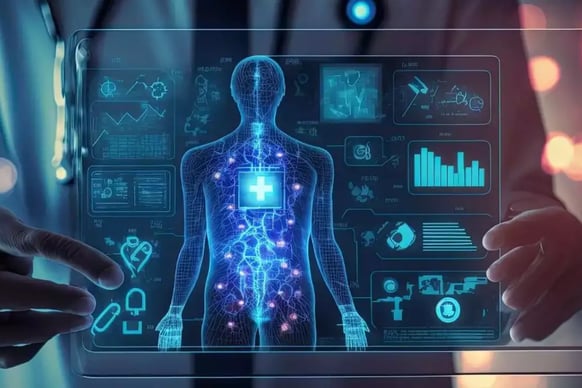The Future of X-Ray Technology: Innovations That Will Change Healthcare
X-ray technology has been a cornerstone of modern medicine for over a century. From detecting bone fractures to diagnosing life-threatening conditions like cancer, X-rays have revolutionized how we view and understand the human body. But as with all technology, the world of X-ray imaging is evolving rapidly. In this blog post, we'll explore some of the most exciting innovations in X-ray technology that promise to reshape healthcare, making diagnoses faster, more accurate, and accessible to people around the world.
3/19/20254 min read


1. AI Integration in X-Ray Imaging
Artificial Intelligence (AI) is one of the most transformative forces in the medical field, and X-ray technology is no exception. AI-powered algorithms are increasingly being integrated into X-ray imaging systems to improve the speed and accuracy of diagnoses. By analyzing medical images, AI can identify patterns and anomalies that might be difficult for human radiologists to detect, such as early signs of cancer, fractures, or infections.
For example, AI has already been successfully used to analyze chest X-rays for signs of pneumonia and tuberculosis, as well as to detect breast cancer in mammograms. These AI systems are trained on thousands of medical images, allowing them to "learn" how to spot critical conditions with incredible precision.
AI technology also speeds up the diagnostic process, which is critical in emergency situations. By quickly analyzing X-ray images, AI can help doctors make fast, informed decisions, potentially saving lives in urgent care settings.
2. Portable X-Ray Machines
Another exciting development in X-ray technology is the advent of portable X-ray machines. Traditional X-ray machines require large, fixed equipment and dedicated spaces, making them difficult to deploy in remote or emergency situations. However, portable X-ray machines are changing the game by offering mobility and flexibility while maintaining high image quality.
These compact machines are particularly valuable in emergency settings, where time is of the essence. They can be used in ambulances, military field hospitals, disaster zones, and even remote villages, bringing diagnostic capabilities to areas that might otherwise lack access to advanced medical equipment.
In addition to being mobile, these devices are also becoming more affordable, making them a viable option for hospitals and healthcare providers in low-resource areas. As the demand for healthcare in underserved regions increases, portable X-ray machines will play an essential role in improving access to essential diagnostic tools.
3. 3D X-Ray Imaging (Tomography)
Traditional X-rays provide a 2D image, which can sometimes be limiting when doctors need to view complex structures or make detailed diagnoses. To overcome this limitation, 3D X-ray imaging, or tomography, is emerging as a powerful tool in medical imaging.
Unlike traditional X-rays, which provide a flat, one-dimensional image, 3D X-ray tomography creates detailed, cross-sectional images of the body, allowing doctors to see structures in three dimensions. This technology is particularly useful for complex surgeries, as it gives surgeons a more accurate view of tissues, bones, and organs.
For example, in dental care, 3D X-ray imaging can be used to view the bone structure of the jaw, detect cavities, or plan dental implants with incredible precision. It’s also used in orthopedics to assess bone fractures, joint diseases, and complex spinal conditions. As 3D imaging becomes more advanced, it promises to improve surgical outcomes by giving healthcare providers a more detailed understanding of a patient's anatomy.
4. Radiation Reduction Techniques
While X-rays are an invaluable diagnostic tool, they do expose patients to a small amount of radiation. Over time, this exposure can add up, especially for individuals who need multiple X-ray scans. As a result, reducing radiation exposure has become a key focus in the development of new X-ray technologies.
Innovations in X-ray equipment have led to the development of techniques that minimize radiation while still producing high-quality images. One example is the use of digital X-rays, which require less radiation than traditional film-based systems. Additionally, advancements in software now allow for the enhancement of images, meaning radiologists can obtain clearer results with lower radiation doses.
New techniques, like low-dose computed tomography (CT), are also being developed to reduce radiation exposure for patients who require repeated imaging. The goal is to strike a balance between obtaining high-quality diagnostic images and protecting patients from unnecessary radiation risks.
5. X-Ray for Non-Medical Applications
While X-rays are primarily associated with medical imaging, they also have applications in a variety of other fields. One of the most well-known non-medical uses of X-rays is in airport security, where X-ray machines are used to scan luggage and identify potentially dangerous items.
However, X-ray technology is also making strides in industries like manufacturing, aerospace, and even archaeology. For example, X-rays are used to inspect the integrity of materials in products like aircraft parts, electronics, and industrial machinery. This process, known as X-ray inspection, helps detect flaws, cracks, and other defects that may not be visible to the naked eye, ensuring the safety and durability of critical components.
In archaeology, X-ray imaging is used to examine ancient artifacts and fossils without damaging them. By using X-rays, researchers can look inside objects and gain valuable insights into their structure and composition, preserving these pieces of history for future generations.
6. Conclusion: Shaping the Future of Diagnostics
The future of X-ray technology is bright, with new advancements that promise to make healthcare more efficient, accurate, and accessible. From the integration of AI to portable X-ray machines and reduced radiation exposure, these innovations are already making a significant impact on how doctors diagnose and treat diseases.
As these technologies continue to evolve, they will not only improve the quality of healthcare for patients around the world but also open up new possibilities for non-medical applications of X-ray technology. With these developments, we are witnessing a new era in medical imaging, one where faster, safer, and more accurate diagnostics will help save lives and improve health outcomes for people everywhere.




Reference Website Links:
National Institutes of Health (NIH) - AI in Healthcare
World Health Organization (WHO) - Portable X-ray Machines
National Cancer Institute (NCI) - AI and Imaging in Cancer Diagnosis
NCI - AI and Medical Imaging
European Society of Radiology (ESR) - 3D Imaging in Radiology
ESR - 3D Imaging in X-ray Technology
Radiology Business - Innovations in X-ray Imaging
Radiology Business - Innovations in X-ray Technology
